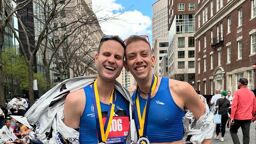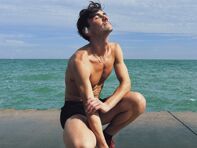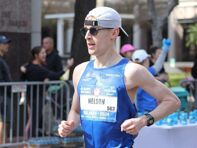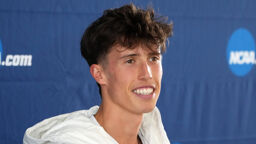All month long, Outsports is revisiting key moments in gay, lesbian, bisexual, transgender and queer sports history as part of LGBTQ history month. Today, we look back at the novel that remains a best seller 45 years after its publication: “The Front Runner.”
Its author, Patricia Nell Warren, died February 9, 2019. Her second novel, “The Front Runner” has sold in excess of 10 million copies since it hit bookshelves in 1974. Here’s how Outsports co-founder Cyd Zeigler reported on the phenomenon this love story created when Outsports chose it as a key moment in LGBTQ sports, on September 30, 2011.
Many would be surprised to know that the best-selling gay novel of all time is a story about a gay coach and his Olympic runner as told in Patricia Nell Warren’s 1974 best seller, ‘The Front Runner.’
The novel centered on college running coach Harlan Brown and runner Billy Sive. Along with friends, the two navigate the homophobic waters of track & field in the 1970s with their hearts set on the Olympic Games. Warren wrote two sequels to ‘The Front Runner’: ‘Harlan’s Race’ (1994) and ‘Billy’s Boy’ (1997).
The novel exploded onto the scene when it was published. It was the first piece of contemporary gay fiction to reach the New York Times Best Seller list, and the Times called it “the most moving, monumental love story ever written about gay life.” Over 10 million copies have been printed in various languages.
Before the Internet, ‘The Front Runner’ for many was that secret look inside gay life. With their bedroom door closed, countless young men locked themselves away as they read this incredible story of gay love. For many, it was the first time they felt someone was telling a story about their personal feelings and emotions. For gay sports fans and athletes, it was the first piece of gay culture that reflected them and their passion for sports.
Warren wasn’t afraid to turn stereotypes on their heads with the book. Not only was she tackling the world of sports, she also created a main character in Harlan Brown the likes of which would ruffle the feathers of people across the political spectrum. Warren pulled from her own experiences growing up around conservative military men to create Brown:
Nobody had created a character like him in gay literature before. We had lots and lots of liberals and people from the world of the arts and the academic world. But a hard-edged coach with a military background who would vote Republican and piss all the liberals off, but especially someone who had never been able to admit that he was not only sexually attracted to men but could love another man, this was all part of the conflict I wanted to create. Billy’s the one putting daisies up the gun barrels of the National Guard, and Harlan’s the National Guard holding the rifle.
Warren has often been asked about the graphic sex scenes in the book as people have wondered how a woman could so accurately and passionately describe sex between two men. Warren points to her imagination as inspiration.
She also visited a gay-porn theater in Manhattan. She would head out on her lunch breaks at Readers Digest dressed in a suit, pay her five dollars, and sit in a theater of gay men watching porn and doing god-knows-what. On her first visit to the theater she was approached by the manager who wondered if she was part of the “vice squad.” When she told the manager she was doing research for a novel, he gave her his card and free access to the theater any time she wanted. She visited a couple more times.
The legacy of the novel lives on for many in their local gay running group, many of which are called the Frontrunners. In New York, Los Angeles, Seattle, London and many other cities, LGBT runners meet up regularly under the “Frontrunner” banner.
In recent years Warren has turned her attention more and more to the American West. Looking back, ‘The Front Runner’ has strong ties to her Montana-born Western heritage. Billy Sive himself is from the West Coast and brings a care-free attitude with him as he meets the gruff, East Coast Harlan Brown.
In Chapter Two of the book, Brown talks about the allure of the West and its same-sex history:
Sometimes I wondered if that peculiar American hatred of homosexuality isn’t a result of its being so rooted, so silent and unacknowledged, yet so pervasive in our history. In school we are taught the Victorian principles of this history. Yet much of that early history is men alone with each other out on the reaches of the continent. Strong young men with all the urges, like my athletes horsing around in the shower rooms. Explorers, scouts, mountain men, trappers, Indian fighters, cowboys, prospectors, trailblazers. Men with their women left hundreds of miles behind, or men with no women at all.
They came to the frontier with that Western puritanism in their consciences, and there they were broken by sexual need, and forced to deny this puritanism and reach out to each other. Once need was satisfied, who knows how many male loves grew up there in the Kentucky wilderness, or out on the plains, or in the dry-baked desert canyons?
Later in the series, Brown heads to California mirroring Warren’s trek back to the West from her time in New York City.
Warren’s latest book, ‘My West,’ is an anthology of her best writings about the American West. She recently presented the book and some of her thoughts about the West at the Autry National Center (video below).
In addition to her books, Warren has been a regular blogger at the Bilerico Project and here at Outsports. From her writings for Outsports came her 2006 anthology, ‘The Lavender Locker Room.’ She’s written various journal pieces on a wide range of political and medical topics. And she even ran for West Hollywood City Council in 2006.
But for many of her gay fans, Warren’s ‘The Front Runner’ will remain her most important contribution to history. Few books in history have been able to take a generation of disenfranchised people in its arms, hold them tight and tell them they are OK just being who they are. ‘The Front Runner’ did that 35 years ago, continues to do that, and is one of the most important moments in our history.
For more information:
- Cyd Zeigler’s obituary for Patricia Nell Warren
- International Frontrunners
- Amazon.com page for “The Front Runner”
Tomorrow— and every day in these last days of October — we’ll bring you another story of LGBTQ Sports history.





































